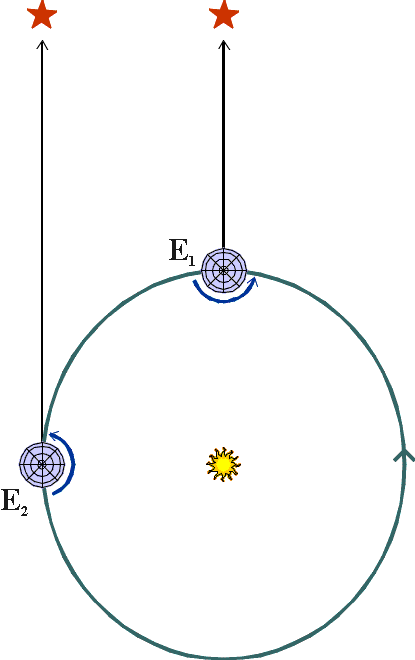-
"الفلك الموضعي"
- مقدمة
- الكرة الأرضية
- هندسة المثلثات الكروية
- ملاحظات حول الهندسة الكروية
- إحداثيات أفقية "alt-az"
- إحداثيات استوائية "HA-dec"
- إحداثيات استوائية "RA-dec"
- الزمن النجمي
- الانتقال بين أفقي و استوائي
- إحداثيات مجرية
- إحداثيات بروجية
- الانتقال بين بروجي و استوائي
- حركة الشمس و ضبط الوقت
- القمر
- الإنكسار الجوي
- شروق و غروب الشمس، الشفق
- اختلاف المنظر المركزي اليومي
- اختلاف المنظر الموسمي
- الزيغ
- المبادرة و الترنح :اضطراب محور الأرض
- تقاويم
- الامتحان الأخير
- الإحداثيات الفلكية، خضر الأحمد
- الحركة الظاهرية للنجوم (تفاعلي)
- الأقطاب السماوية (تفاعلي)

الزمن النجمي

Which stars are on your local meridian? It depends on the time at which you observe. In fact, it depends on both the date and the (clock) time,because the Earth is in orbit around the Sun.
Consider the Earth at position E1 on the diagram. The star shown is on the meridian at midnight by the clock. But three months later, when the Earth reaches position E2 , the same star is on the meridian at 6 p.m. by the clock.
Our clocks are set to run (approximately) on solar time (sun time). But for astronomical observations, we need to use sidereal time (star time).
Consider the rotation of the Earth relative to the stars. We define one rotation of Earth as one sidereal daymeasured as the time between two successive meridian passages of the same star. Because of the Earth's orbital motion, this is a little shorter than a solar day. (In one year, the Earth rotates 365 times relative to the Sun, but 366 times relative to the stars. So the sidereal day is about 4 minutes shorter than the solar day.)
We define Local Sidereal Time (LST) to be 0 hours, when the vernal equinox
 is on the observer's local meridian. One hour later, the local Hour Angle (LHA) of the equinox is +1h (by the definition of
Hour Angle), and the Local Sidereal Time is 1h. So at any instant,
is on the observer's local meridian. One hour later, the local Hour Angle (LHA) of the equinox is +1h (by the definition of
Hour Angle), and the Local Sidereal Time is 1h. So at any instant,
Local Sidereal Time = Local Hour Angle of the vernal equinox.
Here's an alternative definition: suppose that LST = 1h. This means that the vernal equinox has moved 15° (1h) west of the meridian, and now some other star X is on the meridian. But the Right Ascension of star X is the angular distance from the vernal equinox to X = 1h = LST. So at any instant,
Local Sidereal Time = Right Ascension of whichever stars are on the meridian.
And in general,
the Local Hour Angle of a star = Local Sidereal Time - RA of the star.
However, at any instant, different observers, to the east or west, will have different stars on their local meridians. We need to choose one particular meridian to act as a reference point; we choose Greenwich.
We define the Greenwich Hour Angle of X as the Hour Angle of X relative to the celestial meridian at Greenwich. Then we can define Greenwich Sidereal Time (GST) as the Greenwich Hour Angle of the vernal equinox. This gives the important relation
LST = GST - longitude west
.Recall that the Local Hour Angle (LHA) of a star = Local
Sidereal Time - RA of the star. In particular, the Greenwich Hour
Angle (GHA) of a star = Greenwich Sidereal Time - RA of the star.
Combining these, we find
LHA(star) = GHA(star) - longitude west
.تمرين:
At midnight on 1998 February 4th, Local Sidereal Time at St.Andrews was 8h45m. St.Andrews has longitude 2°48'W. What was the Local Hour Angle of Betelgeuse (R.A. = 5h55m) at midnight?
At what time was Betelgeuse on the meridian at St.Andrews?
At what time was Betelgeuse on the meridian at Greenwich?
الحل:
Local Hour Angle = LST - RA
8h 45m - 5h 55m = 2h 50m.
At what time was Betelgeuse on the meridian at St.Andrews?
At what time was Betelgeuse on the meridian at Greenwich?
For a more detailed discussion of Sidereal Time and related topics, see Chapter 2 of USNO Circular No.179.
- إحداثيات استوائية (2)
ترجمة قتيبة أقرع
- تحويلات أفقية - استوائية